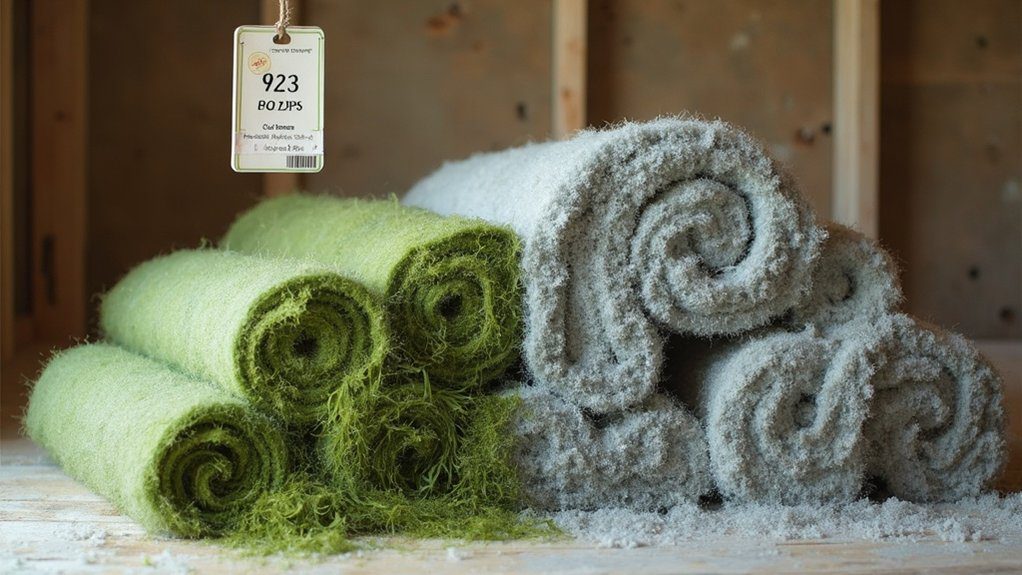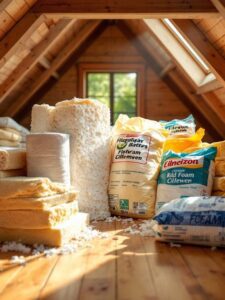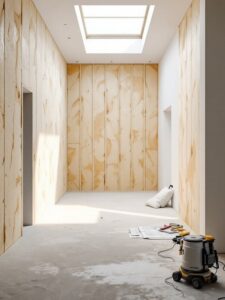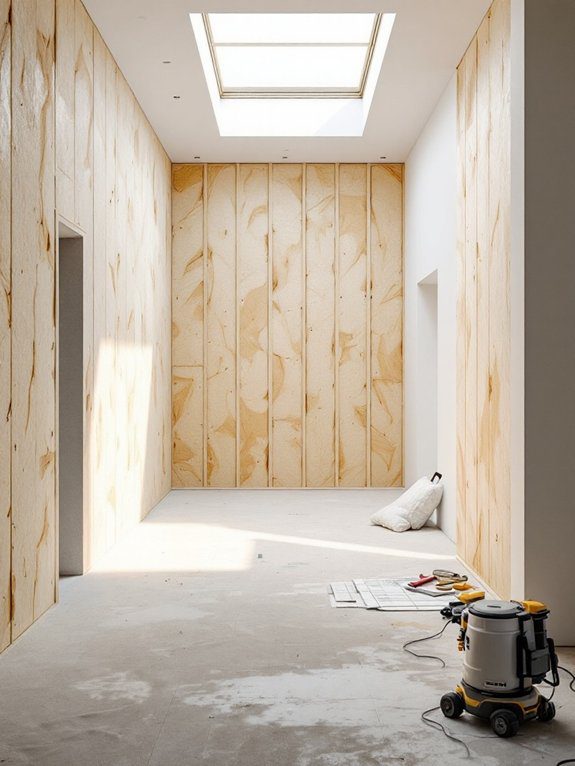While rockwool costs less upfront ($0.75-$1.50/sq ft vs hemp wool’s $1.25-$2.00/sq ft), you’ll find hemp wool’s total ownership costs more economical in the long run. You’ll save 15-25% on installation labor with hemp wool’s easier handling, and it lasts 10-20 years longer than rockwool’s 30-40 year lifespan. Factor in hemp wool’s superior moisture resistance, saving $2-3/sq ft in repairs, and its $0.45/sq ft lower annual cost makes it a smarter investment. Exploring the full cost breakdown reveals surprising advantages.
Key Takeaways
- Rockwool has a lower initial cost at $0.75-$1.50 per square foot compared to hemp wool’s $1.25-$2.00 per square foot.
- Hemp wool installations are completed 30% faster with lower labor costs, reducing overall project expenses significantly.
- Despite higher upfront costs, hemp wool’s 50+ year lifespan versus rockwool’s 30-40 years makes it more cost-effective long-term.
- Hemp wool saves $2-3 per square foot in repair costs due to superior moisture resistance and shape retention.
- The lifetime cost per year for hemp wool averages $0.45 per square foot less than rockwool when considering durability and maintenance.
Understanding Hemp Wool and Rockwool Materials

While both hemp wool and rockwool serve as popular insulation materials, they differ considerably in their composition and manufacturing processes.
You’ll find that hemp properties include natural, renewable fibers harvested from the hemp plant’s stalks, which are processed into insulation through mechanical separation and minimal chemical treatment. This eco-friendly approach typically affects its market price.
In contrast, rockwool characteristics stem from its manufacturing process, where basalt rock and recycled slag are melted at extremely high temperatures (around 2,700°F) and spun into fibers.
You’re looking at a more energy-intensive production method, which influences its cost structure. Understanding these fundamental differences helps you make an informed decision about which material aligns with both your budget and sustainability goals.
Initial Purchase Price Comparison
Three key factors drive the initial purchase price difference between hemp wool and rockwool insulation.
When you’re comparing material sourcing and production costs, you’ll find that rockwool typically costs $0.75-1.50 per square foot, while hemp wool ranges from $1.25-2.00 per square foot. This initial price gap reflects the current market dynamics and manufacturing scale.
- Rockwool benefits from established production facilities and decades of optimized manufacturing processes, keeping costs lower.
- Hemp wool’s material sourcing involves agricultural costs and specialized processing, contributing to higher prices.
- Production volume differences mean rockwool manufacturers can offer bulk discounts more readily than hemp wool producers.
You’ll notice these price variations across different regions and suppliers, but the general pattern holds consistent in most markets.
Installation Costs and Labor Requirements

Beyond the initial material costs, installation expenses represent a major factor in the total project budget.
You’ll find that hemp wool typically requires less specialized labor skillsets compared to rockwool, potentially reducing your installation costs by 15-25%.
While rockwool demands precise cutting tools and protective equipment, hemp wool’s installation techniques are more straightforward.
You can easily cut it with standard utility knives, and it’s less irritating to handle. This means your contractors won’t need to charge premium rates for specialized safety gear or equipment.
The time difference is notable too. Your installation crew can typically complete hemp wool installations 30% faster than rockwool, translating to fewer labor hours on your invoice.
If you’re paying $45-60 per hour for skilled labor, this efficiency difference can greatly impact your bottom line.
Long-Term Cost Analysis and Durability
Although the upfront costs of hemp wool typically run 20-30% higher than rockwool, you’ll recover this difference through superior longevity and reduced maintenance expenses.
When analyzing long term durability, hemp wool maintains its insulating properties for 50+ years, while rockwool’s material lifespan averages 30-40 years before degradation begins.
Consider these cost-saving benefits of hemp wool over time:
- Resists moisture damage without replacement, saving $2-3 per square foot in potential repairs
- Maintains shape and density 25% longer than rockwool, reducing the need for top-ups
- Zero pest treatment costs due to natural insect-repelling properties, compared to rockwool’s periodic treatment needs
When you factor in these durability advantages, hemp wool’s lifetime cost per year averages $0.45/sq ft less than rockwool, making it the more economical choice for value-conscious homeowners.
Environmental Impact and Sustainability Costs

When evaluating the environmental costs between hemp wool and rockwool, the carbon footprint calculations reveal significant differences in their sustainability profiles.
You’ll find that hemp wool’s production generates approximately 0.6 kg CO2/kg, while rockwool produces around 1.5 kg CO2/kg, translating to higher environmental costs in the long run.
Your investment in eco friendly materials like hemp wool supports sustainability practices that reduce manufacturing energy costs by 50% compared to rockwool.
While rockwool requires temperatures of 1,600°C for production, hemp wool processing needs minimal energy input.
You’ll also save on disposal costs, as hemp wool is 100% biodegradable, whereas rockwool may incur additional expenses for proper disposal.
These factors contribute to hemp wool’s lower environmental impact costs, despite its higher initial price point.
Regional Price Variations and Availability
Market prices for hemp wool and rockwool fluctuate greatly across different regions, with hemp wool costing $2.50-4.00 per square foot in North America compared to rockwool’s $1.20-1.80.
You’ll find regional pricing varies based on manufacturing location and distribution networks. While rockwool’s established supply chains keep costs relatively stable, hemp wool’s local availability can impact pricing substantially.
- European markets typically offer hemp wool at 15-20% lower costs due to established hemp farming infrastructure.
- Western U.S. states show higher rockwool prices due to transportation costs from eastern manufacturing plants.
- Local availability in rural areas can increase prices by 25-40% for both materials.
When you’re comparing costs in your area, check multiple suppliers and consider bulk ordering to offset regional price differences.
You might find better deals through building supply cooperatives or direct-from-manufacturer purchases.
Energy Savings and Return on Investment

Initial costs tell only part of the story when evaluating hemp wool versus rockwool insulation.
When you consider long-term energy efficiency, hemp wool can save you 15-20% more on heating and cooling costs compared to rockwool. While hemp wool’s upfront cost is typically 30% higher, you’ll recoup this investment through energy savings within 5-7 years.
Your return on investment accelerates in regions with extreme temperatures. Hemp wool’s superior thermal performance means you’ll spend less on HVAC usage, potentially saving $200-300 annually on energy bills.
Plus, hemp wool maintains its insulating properties longer than rockwool, lasting up to 50 years without degradation. When calculating cost savings over the material’s lifetime, hemp wool’s durability and consistent performance make it an economically sound choice despite higher initial expenses.
Maintenance and Replacement Expenses
Once installed properly, hemp wool requires virtually no maintenance costs over its lifetime, while rockwool may need periodic inspections and repairs that average $150-200 per incident.
You’ll find that hemp wool’s maintenance frequency is minimal, with a replacement timeline of 50+ years when installed correctly.
Your investment in rockwool typically requires more attention over time:
- Moisture damage inspections cost you $75-100 annually
- Compaction checks and potential repositioning every 5-7 years run $200-300
- Full replacement may be needed after 25-30 years, costing $2-3 per square foot
When you’re calculating long-term expenses, factor in that hemp wool’s durability eliminates most maintenance costs.
The natural fiber structure maintains its shape and performance, making it a more cost-effective choice for fellow homeowners focused on reducing ongoing expenses.
Building Code Requirements and Certification Costs

While both insulation materials must meet building codes, hemp wool’s certification costs typically run 15-20% higher than rockwool due to its newer market status.
You’ll need to budget an additional $500-800 for hemp wool’s certification processes compared to rockwool’s more established procedures.
When choosing between these materials, consider that rockwool’s certifications are standardized across most regions, costing around $2,000-3,000.
Hemp wool often requires specialized testing and documentation, pushing total certification costs to $2,500-3,800.
However, you’re part of a growing movement toward sustainable building practices, and these upfront costs may be offset by increasing market acceptance.
Local building codes may also affect your expenses.
Some jurisdictions offer incentives for eco-friendly materials like hemp wool, potentially reducing your certification costs by 10-15% through rebates or tax credits.
Frequently Asked Questions
Can Hemp Wool and Rockwool Be Used Together in the Same Project?
You can combine hemp wool and rockwool in your project, but watch for compatibility concerns with moisture levels. It’s cost-effective when you maximize each material’s strengths, though this might impact overall project efficiency.
Does Either Insulation Type Affect Indoor Air Quality Over Time?
You’ll find hemp insulation actively improves your indoor air by filtering pollutants, while rockwool remains neutral. Though hemp costs more upfront, you’re investing in better air quality for your home’s lifetime.
Are There Insurance Premium Differences When Using Hemp Wool Versus Rockwool?
You’ll be jumping for joy – most insurers don’t charge different premiums for hemp wool versus rockwool. While premium variations exist between companies, your insurance costs typically won’t change based on these insulation choices.
Which Insulation Type Is Better for Soundproofing Between Floors?
You’ll find Rockwool’s higher material density makes it superior for soundproofing between floors. While it’s typically 15-20% costlier than hemp wool, its proven soundproofing effectiveness justifies the extra investment for your home.
Can These Insulation Materials Be Recycled After Removal During Renovations?
You’ll find that hemp wool is 100% recyclable with minimal environmental impact, while rockwool’s recycling processes are more complex and costly. Your choice affects both disposal expenses and our planet’s well-being.
Conclusion
When you’re weighing hemp wool against rockwool, the numbers tell a clear story. While hemp wool’s upfront cost is 15-20% higher than rockwool’s $0.75-1.50 per square foot, it’s like choosing between a silk purse and a polyester wallet. Hemp wool’s 50+ year lifespan and 20% better energy efficiency mean you’ll save around $3,000 over two decades, making it the golden investment for your home’s future.









One Response
Thankyou for this post, I am a big big fan of this website would like to go on updated.